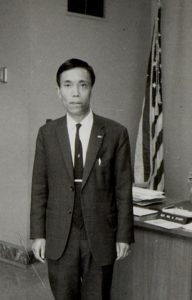My Life — Interview with Hiromu Morishita (1930–), A-bomb survivor and teacher, Part 10: Hiroshima–Nagasaki World Peace Pilgrimage
May 3, 2022
Positive response overseas to A-bomb survivors’ stories
On the Hiroshima–Nagasaki World Peace Pilgrimage, we first traveled across the United States. While staying in homes of supporters, we paid visits to schools and citizens’ groups, and appeared at assemblies and gatherings. We met many well-intentioned people. Some justified the atomic bombings, but we found that everybody tried hard to carefully listen to what we had to say.
Hiromu Matsushita also met with Harry S. Truman, U.S. president at the time of the atomic bombings. Local media all reported it as a “historic meeting.”
The venue for the meeting was the Harry S. Truman Presidential Library and Museum in the U.S. state of Missouri. The late Takuo Matsumoto (former principal of Hiroshima Jogakuin University) stood at the podium on behalf of the A-bomb survivors as around eight of us looked on from below. My impression of Mr. Truman was that he had aged considerably. How long do you think the meeting lasted? Only about three minutes. I wrote in my notebook, “At first, my heart was palpitating. But the meeting was utterly disappointing.” I added the question, “Didn’t he think about the many young lives that were lost?”
Mr. Truman mentioned his hope that ‘such a thing’ would never happen again. I couldn’t understand if he was referring to the war or to the dropping of the atomic bombs. Of course, he failed to speak a single word that resembled our hoped-for apology. On the contrary, he emphasized that the atomic bombings were designed to prevent mass casualties and to end the war.
My expectations had been betrayed. The pilgrimage, however, helped me set the course of my peace activities. The A-bomb survivors, who had long felt dejected, shared their experiences in the atomic bombings in major cities around the world. It was not as if the A-bomb survivors were licking each other’s wounds. Audiences listened and responded to our thoughts and feelings and came to say that the atomic bombings were wrong. The stones we threw into the pond rippled in all directions, and we were all swept up in the resulting waves. Based on that feeling, I began to understand my own mission.
At the headquarters of the United Nations in New York, we met with then UN Secretary-General U Thant and urged him to conduct scientific research into the damage caused by the atomic bombings. In Moscow, we called for the abolition of nuclear weapons in front of around 2,000 citizens. I came to have the belief that we could do big things we had not expected before. We also came into contact with the state of international affairs during the Cold War. One example was East and West Germany. Impressive for me was the scene in which East Germany turned pitch black after sunset, while West Germany was brightly illuminated with electric lights.
All of this was made possible by the support of many people, especially the amazing Barbara Reynolds. Though her strong convictions and use of her own finances, she made the pilgrimage possible.
(Originally published on May 3, 2022)








